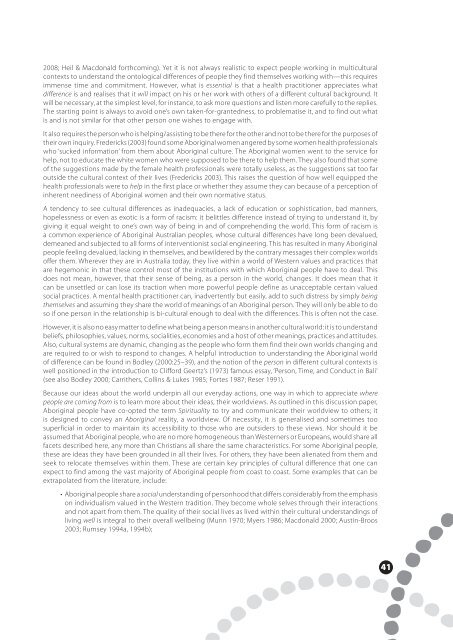DP9-Aboriginal-Spirituality
DP9-Aboriginal-Spirituality
DP9-Aboriginal-Spirituality
You also want an ePaper? Increase the reach of your titles
YUMPU automatically turns print PDFs into web optimized ePapers that Google loves.
2008; Heil & Macdonald forthcoming). Yet it is not always realistic to expect people working in multicultural<br />
contexts to understand the ontological differences of people they find themselves working with—this requires<br />
immense time and commitment. However, what is essential is that a health practitioner appreciates what<br />
difference is and realises that it will impact on his or her work with others of a different cultural background. It<br />
will be necessary, at the simplest level, for instance, to ask more questions and listen more carefully to the replies.<br />
The starting point is always to avoid one’s own taken-for-grantedness, to problematise it, and to find out what<br />
is and is not similar for that other person one wishes to engage with.<br />
It also requires the person who is helping/assisting to be there for the other and not to be there for the purposes of<br />
their own inquiry. Fredericks (2003) found some <strong>Aboriginal</strong> women angered by some women health professionals<br />
who ‘sucked information’ from them about <strong>Aboriginal</strong> culture. The <strong>Aboriginal</strong> women went to the service for<br />
help, not to educate the white women who were supposed to be there to help them. They also found that some<br />
of the suggestions made by the female health professionals were totally useless, as the suggestions sat too far<br />
outside the cultural context of their lives (Fredericks 2003). This raises the question of how well equipped the<br />
health professionals were to help in the first place or whether they assume they can because of a perception of<br />
inherent neediness of <strong>Aboriginal</strong> women and their own normative status.<br />
A tendency to see cultural differences as inadequacies, a lack of education or sophistication, bad manners,<br />
hopelessness or even as exotic is a form of racism: it belittles difference instead of trying to understand it, by<br />
giving it equal weight to one’s own way of being in and of comprehending the world. This form of racism is<br />
a common experience of <strong>Aboriginal</strong> Australian peoples, whose cultural differences have long been devalued,<br />
demeaned and subjected to all forms of interventionist social engineering. This has resulted in many <strong>Aboriginal</strong><br />
people feeling devalued, lacking in themselves, and bewildered by the contrary messages their complex worlds<br />
offer them. Wherever they are in Australia today, they live within a world of Western values and practices that<br />
are hegemonic in that these control most of the institutions with which <strong>Aboriginal</strong> people have to deal. This<br />
does not mean, however, that their sense of being, as a person in the world, changes. It does mean that it<br />
can be unsettled or can lose its traction when more powerful people define as unacceptable certain valued<br />
social practices. A mental health practitioner can, inadvertently but easily, add to such distress by simply being<br />
themselves and assuming they share the world of meanings of an <strong>Aboriginal</strong> person. They will only be able to do<br />
so if one person in the relationship is bi-cultural enough to deal with the differences. This is often not the case.<br />
However, it is also no easy matter to define what being a person means in another cultural world: it is to understand<br />
beliefs, philosophies, values, norms, socialities, economies and a host of other meanings, practices and attitudes.<br />
Also, cultural systems are dynamic, changing as the people who form them find their own worlds changing and<br />
are required to or wish to respond to changes. A helpful introduction to understanding the <strong>Aboriginal</strong> world<br />
of difference can be found in Bodley (2000:25–39), and the notion of the person in different cultural contexts is<br />
well positioned in the introduction to Clifford Geertz’s (1973) famous essay, ‘Person, Time, and Conduct in Bali‘<br />
(see also Bodley 2000; Carrithers, Collins & Lukes 1985; Fortes 1987; Reser 1991).<br />
Because our ideas about the world underpin all our everyday actions, one way in which to appreciate where<br />
people are coming from is to learn more about their ideas, their worldviews. As outlined in this discussion paper,<br />
<strong>Aboriginal</strong> people have co-opted the term <strong>Spirituality</strong> to try and communicate their worldview to others; it<br />
is designed to convey an <strong>Aboriginal</strong> reality, a worldview. Of necessity, it is generalised and sometimes too<br />
superficial in order to maintain its accessibility to those who are outsiders to these views. Nor should it be<br />
assumed that <strong>Aboriginal</strong> people, who are no more homogeneous than Westerners or Europeans, would share all<br />
facets described here, any more than Christians all share the same characteristics. For some <strong>Aboriginal</strong> people,<br />
these are ideas they have been grounded in all their lives. For others, they have been alienated from them and<br />
seek to relocate themselves within them. These are certain key principles of cultural difference that one can<br />
expect to find among the vast majority of <strong>Aboriginal</strong> people from coast to coast. Some examples that can be<br />
extrapolated from the literature, include:<br />
• <strong>Aboriginal</strong> people share a social understanding of personhood that differs considerably from the emphasis<br />
on individualism valued in the Western tradition. They become whole selves through their interactions<br />
and not apart from them. The quality of their social lives as lived within their cultural understandings of<br />
living well is integral to their overall wellbeing (Munn 1970; Myers 1986; Macdonald 2000; Austin-Broos<br />
2003; Rumsey 1994a, 1994b);<br />
41


